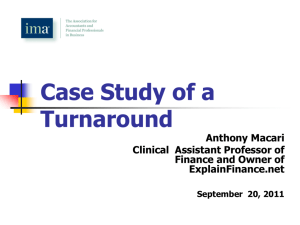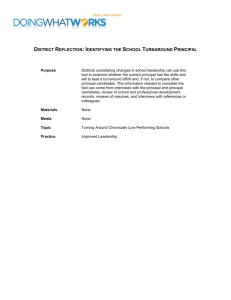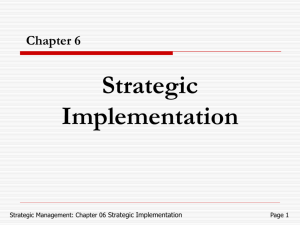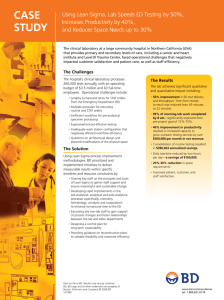Document
advertisement
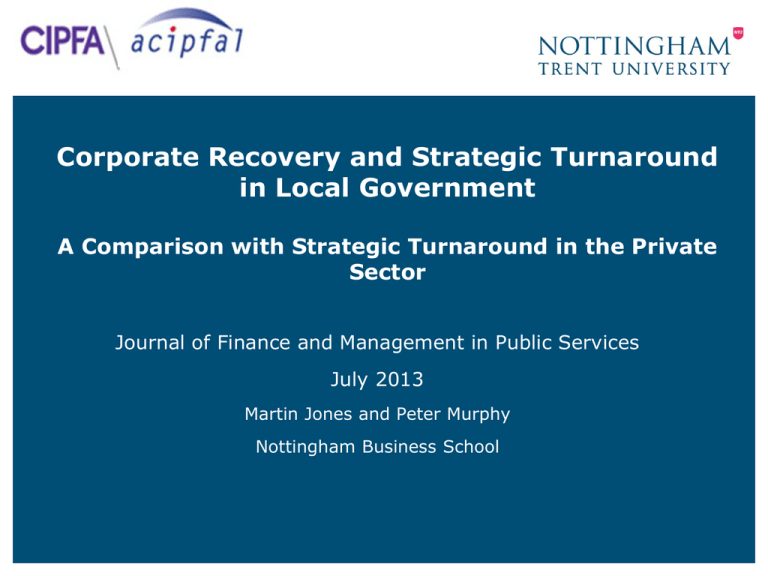
Corporate Recovery and Strategic Turnaround in Local Government A Comparison with Strategic Turnaround in the Private Sector Journal of Finance and Management in Public Services July 2013 Martin Jones and Peter Murphy Nottingham Business School Objectives of the Research • This paper is based on research being undertaken by the authors into strategic turnaround in English local government as a result of the CPA performance assessment regime undertaken by the Audit Commission between 2002 and 2009. • One of the authors is undertaking a doctoral study into the subject area and the other was previously a lead official within the CPA regime • The objectives of the research are as follows: – Identify the themes and approaches to corporate turnaround emerging from literature in the public and private sectors – Through case studies of English local authorities, identify whether there were any similarities or differences in approaches taken to strategic turnaround during CPA 23 March 2016 2 Strategic Turnaround – What do we mean? • An increasing field of study in the private sector • Globalisation, advances in technology, the cost of capital, increasingly competitive and complex business environments and the increasing number of bankruptcies • Definitions: – the actions taken to bring about a recovery in a failing organisation (Pandit 2000). – decline followed by performance improvement (Schendel et al 1976, Robbins and Pearce 1992) – ‘a process that takes a company from a situation of poor performance to a situation of good sustained performance’ (Brandes and Brege 1993, p92). • A growing body of literature in local government but little on sustained turnaround and recovery. 23 March 2016 3 Positioning of Local Government Turnaround within the Literature 23 March 2016 4 Characteristics of Strategic Turnaround (Private Sector) • Operating versus Strategic Turnaround (Hofer 1980) – Strategic = new business models – Operational = focus on reduced costs/increased revenues – Turnarounds fail if operational used when strategic required – Need to understand the cause of decline • Strategic Adjustment or Strategic Change? (Snow and Hambrick 1980) – Using familiar responses (Cyert and March 1963) – Overlaying past successes – over learning (Starbuck et al 1978) – Roast Pig (Moss Kanter 1983) • Turnaround as a Distinct Phase of Strategy – An episode in an organisations lifecycle (Mintzberg and Walters 1992) – If organisations were good at strategy they would not be failing 23 March 2016 5 Process of Strategic Turnaround (Private Sector) • Realignment (Filatotchev and Toms 2006) – Bringing together internal and external stakeholders at an early stage – Does the organisation have the facility to enter retrenchment? – If not give up • Retrenchment followed by Recovery (Hofer 1980, Robins & Pearce 1992) – Efficiencies through downsizing etc – operational turnaround – Longer term market focus – strategic turnaround • The role of the change agent (Khandwalla 1983) – Credible – Mobilising the organisation – Participative rather than ‘terror tactics’ – Building and rebuilding links to external stakeholders – Sharing and open cultures 23 March 2016 6 Situational Factors Impacting on Turnaround • Luck and timing (Wren 2001) • Organisational size (Francis and Desai 2005, Landrum et al 2000) – can absorb shocks if larger – can put off the need to turnaround if larger – But rigid structures can constrain – And can miss the triggers of decline • Environmental factors - causes and constraints (Dess and Beard 1984) • Factors of decline can impact on recovery - severe and rapid erosion of resources (Pfeffer and Salanick 1978) 23 March 2016 7 Causes of Poor Performance (Local Government) • Self-Regulating v Permanently Failing (Jas and Skeltcher 2005) – Performance fluctuates over time – Where in control then self-regulating – Where lack the necessary skills then permanently failing • Cognition, Capability, Capacity (Turner and Whiteman 2005) – Identifying that poor performance exists – Having the right leadership skills….. – …..in sufficient quantity • Stress Rigidity or Threat Rigidity (Straw 1981) – Becoming retrenched against the changing environment – The fallacy of past successes • Situational Factors (Usually internal – (Turner and Whiteman (2005)) – Culture – History – Politics 23 March 2016 8 Strategic Turnaround Responses (Local Government) – early literature • Replacement, Retrenchment, Renewal (Boyne 2004) – Key members of the leadership are replaced – Short term actions taken to address crisis triggers – Longer term actions necessary to improve performance • Twin Track Approach (Paton and Mordaunt 2004) – Old blood mixed with new blood – Negatives (eg cut backs) run concurrently with positives (eg investments) – Centralising financial control while decentralising in other areas to foster involvement – Leadership creates capacity to change rather than directing change • Avoid Reductionism (Paton and Mordaunt 2004) – Recognise the complexity of the environment – Runs counter to simplification arguments proposed for the private sector (Baden-Fuller and Stoppard 1994) 23 March 2016 9 Case Study Authorities Excellent North East Derbyshire Performance Coventry Northampton Poor 1st CPA CPA +1 CPA +2 CPA +3 Time - Years 23 March 2016 10 North East Derbyshire District Council Findings and Conclusions – Historical factors led to entrenched position with lack of cognition – Poor performance caused by internal rather than external factors – Permanently failing, inward looking culture developed out of the above – External trigger of CPA prompted change – Intervention and temporary change agents were key – Turnaround was a distinct phase a strategy – Step change, not adjustment – Realignment but not retrenchment – Capability and Capacity – Cause of failure but now improved – Reductionist based Operational Turnaround preceded Strategic Turnaround with improved cognition – Twin Track Approach – Yes, facilitated by intervention programme and use of external “friends” eg PCT, University partners – Now potentially Self regulating – (But prepared for age of Austerity?) 23 March 2016 11 Coventry City Council Findings and Conclusions – Opposite of the entrenched position of North East DC - by the time the CPA announced and Lead Official and Monitoring Board appointed, Coventry had started to recover. 1st council (after the pilot authorities)visited by the AC and Intervention team in January 2002. Causes of poor performance were both internal and external. – Coventry recognised its poor performance before the field work by the Audit Commission and the later announcement of results. By the time of the CPA results it had appointed a completely new Management Team (in this case a competent and experienced management team) and the Council had a new leader. – It adopted a twin track approach to both strategic and operational turnaround and addressing inward looking organisational culture. – After a very short time period, the Lead Official and new CEO could adopt a close collaborative strategy and relationship and Coventry’s recovery was triggered by previous service inspections and accelerated rather than triggered by intervention. – Time lags over financial and some other performance indicators meant that there were some early confused messages about recovery but once it became clear that the key services were also improving sustainably, a supportive rather than interventionist approach could be adopted. 23 March 2016 12 Northampton Borough Council Findings and Conclusions – Despite being a very late case (that could have learnt from earlier CPA and interventions) historical factors led to entrenched positions with a lack of cognition by both politicians and officials. – Eventually a new externally sourced CEO and management team were appointed (who both proved inadequate to the task). Initially ODPM would not allow replacement of politicians – this case was to change that stance. – Poor relationships between new CEO/new Management Team/Politicians/Lead Official persisted – Despite a ‘strategic’ approach being adopted to recovery, poor inspection and audit reports, PIs and peer reviews persisted. False starts, unfulfilled ‘promises# of improvement characterised early period by CPA+2 external indicators were flashing red. – New politicians, new CEO, new management team, new twin track approach to strategic and operational intervention – This case had the first co-ordinated networked intervention teams (CDRP and Culture and Leisure network) – precursor to CAA. 23 March 2016 13 Summary • A variety of causes of poor performance – Internal and External – No single over-riding factor – each case different and complex – But… poor leadership cognition a common factor • The ‘triggers’ for turnaround differed too – Threat of CPA – Intervention – Internal cognition • But some commonality in responses – Change of leadership (Member and Officer) – Twin track approaches – operational and strategic – Improvement in cognition and self-awareness (but timescales differed) – Turnaround was a distinct phase in organisational lifecycle • But…..be aware of false starts 23 March 2016 14 Questions? • Contact details • martin.jones@ntu.ac.uk • peter.murphy@ntu.ac.uk 23 March 2016 15

